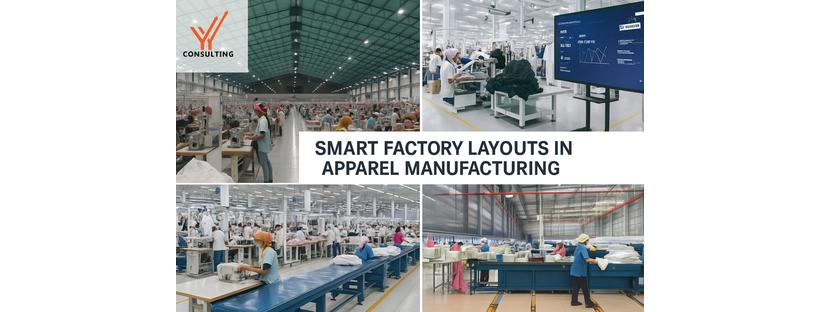Vietnam’s position as a global apparel powerhouse is rapidly strengthening, with export hubs in Ho Chi Minh City, Hanoi, and Binh Duong at the center of this growth. However, to remain competitive, Vietnamese factories must look beyond traditional production methods. One of the most effective ways to achieve this is through smart factory layouts—a blend of strategic design, digitalization, and efficiency engineering that maximizes space utilization, reduces waste, and significantly boosts output.
The Shift Towards Smart Factory Layouts
Traditionally, factory layouts in the apparel sector were process-driven, with isolated workstations and long material flow cycles. While functional, these layouts often lead to bottlenecks, underutilized spaces, and longer lead times.
Smart factory layouts, on the other hand, take a holistic approach—integrating lean manufacturing, real-time data, ergonomics, and modular design to ensure each square meter of factory space is optimized. In the context of Vietnam’s high-growth manufacturing industry, this shift is both timely and necessary.
Why It Matters in Vietnam’s Apparel Industry
Vietnam’s apparel exports exceeded $44 billion in 2023, and yet many factories continue to operate with legacy layouts that underutilize available floor space and labor potential. The rising cost of labor, increasing compliance pressures, and demand for faster turnaround times necessitate a rethink of how factories are designed.
Groyyo’s insights suggest that effective factory layout planning can lead to:
- A 15–30% boost in line efficiency
- A reduction of idle time by 22%
- A cut in cutting-to-packing TAT by 18 hours per cycle
- A 40% reduction in floor congestion, leading to improved safety and productivity
These improvements directly impact cost savings, customer satisfaction, and the ability to scale operations without needing to expand physical infrastructure.
Understanding Layout Types: One Size Doesn’t Fit All
A key part of designing smart layouts is choosing the model that aligns best with production goals:
- Process-Oriented Layouts are ideal for factories dealing with high-variety, low-volume SKUs.
- Product-Oriented Layouts suit mass production where workstations are arranged in sequence.
- Cellular Layouts promote flexibility, allowing smaller teams to handle end-to-end processes.
- Hybrid Layouts merge the above, offering agility without sacrificing efficiency.
Vietnam’s fragmented manufacturing base requires factories to be agile. Hybrid and cellular layouts are gaining traction among mid-sized factories looking to increase output while remaining responsive to varied client demands.
The Role of Digital Tools and Industry 4.0
Smart layouts go hand in hand with digital tools. CAD-based layout simulations help pre-visualize factory design, avoiding costly trial-and-error implementations. Real-time Management Information Systems (MIS) allow supervisors to monitor KPIs like line balancing, output per operator, and downtime in real time.
Furthermore, tools like digital twins and IoT-enabled machines create feedback loops, identifying layout inefficiencies and triggering corrective actions on the go. In factories supported by Groyyo, these tools have led to significant real-world benefits, such as early detection of line imbalances and auto-adjustment of workstation loads.
Best Practices for Implementation
- Time and Motion Studies: Essential for identifying inefficiencies in current layouts and quantifying the impact of change.
- Material Flow Mapping: Helps reduce excessive movement of materials, which adds no value.
- Zoning and Space Planning: Dividing the floor into logical zones—cutting, sewing, finishing, and packing—minimizes cross-traffic and chaos.
- Ergonomics and Safety: Smarter layouts reduce worker fatigue and create safer environments, leading to higher productivity and fewer accidents.
- Modular Equipment and Trolleys: Allow easy reconfiguration of lines to meet changing production demands.
Workforce and Change Management
Smart layouts are not just about equipment and blueprints—they also involve people. Re-training staff for new movement paths, ergonomic postures, and line balancing responsibilities is crucial. Supervisors play a key role in ensuring that transitions are smooth, and that output doesn’t suffer during the switch.
Groyyo incorporates on-ground training modules, including visual SOPs and hands-on trials, to help factory teams adapt faster. In many factories, this has reduced layout transition downtime by up to 35%.
Sustainability Through Layout Efficiency
Sustainability goals are easier to achieve in a well-designed factory. Smart layouts reduce:
- Material waste by minimizing movement and damage
- Energy usage by optimizing lighting, HVAC zones, and machine placement
- Carbon footprint by eliminating unnecessary processing loops
For brands demanding green manufacturing standards, factory layout is often the hidden lever that determines compliance and performance.
Groyyo’s Role in Smart Layout Transformation
As a leading consulting partner in the apparel manufacturing ecosystem, Groyyo has been at the forefront of factory transformation projects across Vietnam.
What Groyyo Offers:
- Factory Audit & Layout Blueprinting
Every engagement starts with a ground-level audit—analyzing workflow, production zones, worker motion paths, and machine layout. - CAD-Based Planning
Using layout simulation tools, Groyyo creates efficient factory blueprints aligned to SKU mix, output targets, and expansion goals. - MIS Integration
Real-time dashboards to monitor KPIs like hourly output, downtime, rejection rates, and resource utilization. - Execution Support
From rearranging workstations to training supervisors and operators, Groyyo offers full implementation support.
Future Outlook
Vietnam’s apparel manufacturers stand at a strategic crossroads. With brands expecting more agility and compliance, and global demand requiring faster production at lower cost, factory layout will increasingly become a competitive differentiator.
Smart layouts are not a luxury—they are a necessity. And with partners like Groyyo bringing global best practices tailored to local contexts, Vietnamese factories can unlock greater value from the same footprint.

Divya Mohan
General Manager (International Business)
divyamohan@groyyo.com


Leave a Comment